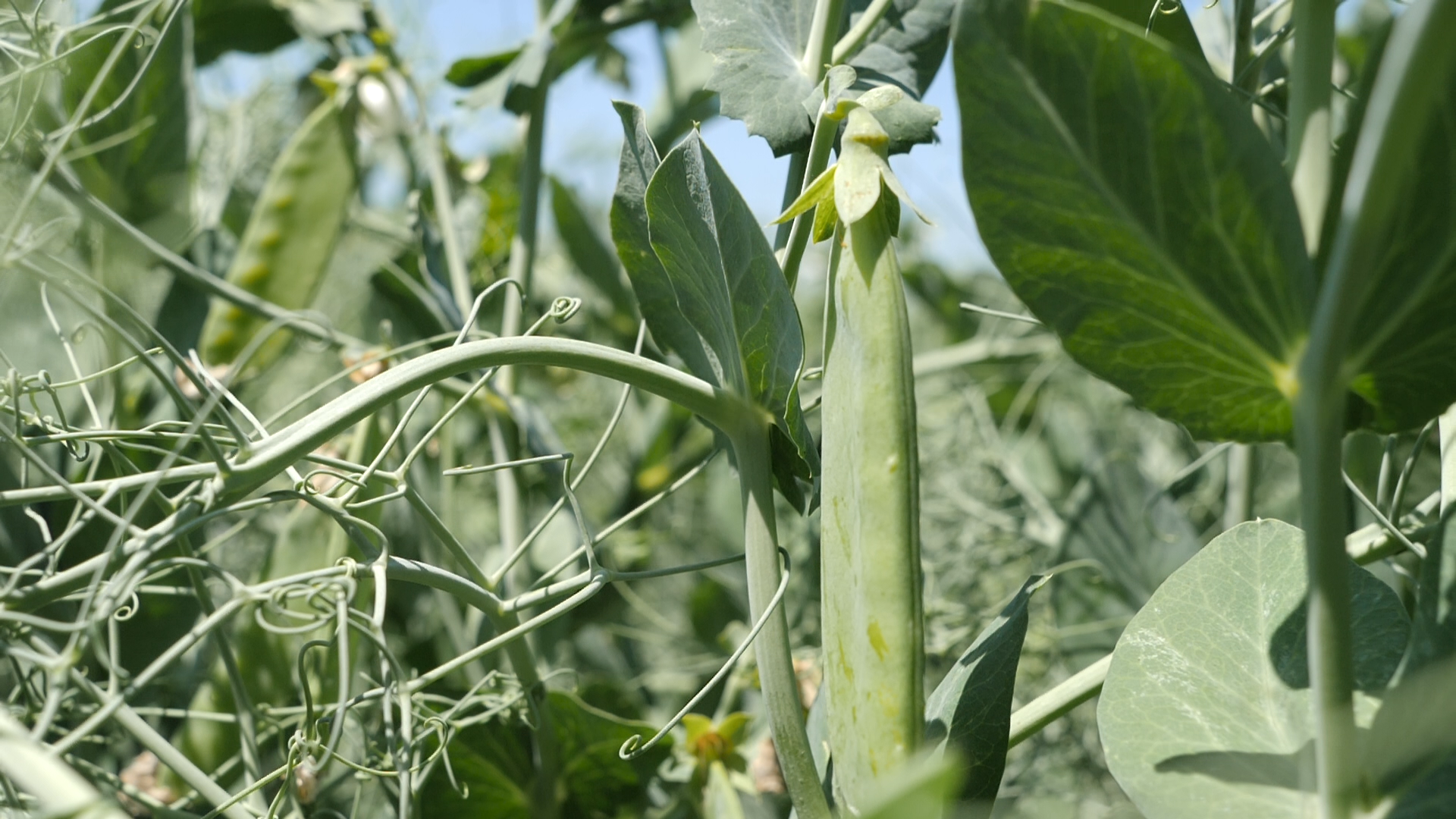Minnesota's Alt-Meat Revolution: Give Peas a Chance?
To state the obvious: The primary source of protein in plant-based fake meats comes from plants.
Okay, great. I wanted to start there because someone needs to grow those plants. This PURIS facility here in Dawson can process 20,000 metric tons of pea protein a year, but they need farmers to grow the PURIS-bred yellow field pea to process.
Luke Peterson runs A-Frame Farm with his family. They're an organic grain and livestock operation right in the shadow of PURIS' Dawson plant. "When PURIS moved into town originally my first thought was, 'Great, I'm gonna have a processing facility to bring peas to three miles from town,'" Peterson said. "I think a lot of farmers thought the same."
I did too, with PURIS so close, what a great opportunity for farmers in southwest Minnesota to introduce a new crop to their rotation. But has that happened? Is southwest Minnesota becoming the new pea belt?
Reily Bata is a fifth generation farmer in Langdon, North Dakota". Our farm's been here since 1893. And I've been farming with my dad since 2009"
Conventional farmers like Reily Bata see peas as a chance to bring crop diversity to their farms. More diversity means healthier soil and less money spent on fertilizers. At Bata Farms, they mainly grow wheat, canola and some soybeans. But they've also started growing about 1,000 acres of peas every year.
Turns out there's no pea belt or hardly any growing of peas in southwest Minnesota. This year, PURIS had a strong grower footprint in Montana and the Dakotas. In northeast North Dakota, 342 miles from Dawson, the Batas have been growing peas since 2020 on their farm in Langdon.
"Peas honestly work pretty good on our soil conditions on our farm," said Reily Bata.
Brent Reck is a procurement manager at PURIS — he recruits pea growers and is the main point of contact for farmers across the U.S. "We're very fortunate that a lot of growers that we work with are very forward-thinking and they're looking at the ability to add crop diversity, add productivity to their soil," he said. Even though the growing season concludes in the fall, Brent needs to make sure they're getting peas delivered to their processing facility all year. "I work fairly closely both with our plants as far as what that demand planting is for what we will need for raw product inbound throughout a whole year," he explained. "I'm working at the same time with growers throughout the U.S. on contracting their acres, what that crop planning is gonna be for that next spring. So then that way we can match up what our demand is with what our future supply will be."
The Batas have a full production Act of God contract with PURIS. This means no matter how much pea yield they have, PURIS will buy it all. And if there's a weather-related disaster that impacts planting or harvesting, they're not penalized for yield they don't have. "When I work directly with our growers, it's not about working with a grower for one year. It's about being able to work with a grower year after year," said Brent.
Brent has worked with the Batas for four years and over the course of Reily's 14 years of farming, he's noticed other farmers thinking about diversity, too. "Sunflowers are coming back in the rotations quite a bit and then there's substantially more peas growing in the area. Corn is moving its way up here," said Bata.
Okay, let's talk about corn.
"There's about 90, 85 to 90 million acres of corn and soy grown in the United States. There's about 1 million acres of peas," explained Nicole Atchison, the CEO of PURIS Holdings and Acremade. (Acremade is PURIS' direct-to-consumers food brand.)
Why does the U.S. have so much corn and so few peas?
"It has been record corn and soy years," said Atchison. "So we've been primarily seeing interest in places where people can't grow corn and soy."
It's starting to become clear why the summertime landscape in southwest Minnesota is field after field of corn and soybeans — and practically only corn and soybeans. It's all about the market.
Patrick Miller is a insurance agent in Dawson. "If I wanna do a specialty crop and there's no market for it, I have to essentially create a market. There's huge markets everywhere for corn and soybeans. There are two spots in every town I can deliver my corn and soybeans, almost," he said.
The reason why farmers talk about corn and soybeans, often in the same breath, is because they rotate well together. Corn needs a lot of nitrogen to grow and soybeans put nitrogen back into the ground. But two crops does not a diverse farming operation make. And our ag system doesn't really support diversity.
"We'd love to be on a wheat rotation 'cause that helps weed control, that helps with soil-based diseases, that helps with bugs," said Miller. "But I'm just gonna say, for $25 an acre I can apply an insecticide. If I'm gonna lose $200 an acre growing wheat I mean, the math is pretty, pretty simple."
Farming is a well-established and entrenched system. And when farmers and companies work outside of it, they run up against another complex system known as the Federal Crop Insurance Program. Before crop insurance, farmers had little to no safety net. So during a bad year, farmers were kind of outta luck. In 1938, the U.S. government introduced the foundation of what we now know as the Federal Crop Insurance Program a system where a selection of high-producing crops are more or less guaranteed by the feds.
The federal government pays about 60% of a farmer's total insurance premiums. And from 1995 to 2020, about 76% of insurance payouts went to producers of four crops: corn, soybeans, wheat and cotton. So U.S. farmers mostly grow corn, soybeans, wheat and cotton. The county that Dawson is in, Lac qui Parle County, doesn't have an insurance policy for yellow field peas. So, when PURIS tries to convince farmers to grow the pea here, they also have to convince farmers to give up the safety net of crop insurance.
Patrick Miller is in a unique position to understand this system. He sells insurance in Dawson, but he also farms in the next town over.
"It's nothing to spend a half-a-million dollars before anything comes outta the ground just to plant my farm," explained Miller. "If you don't have guaranteed coverage through crop insurance you're never gonna get an operating loan."
It really all comes down to how these resources are valued. And currently, yields and cash are king.
"It's hard when you take a specific crop and try to attach it a dollar amount to it," Luke Peterson from A-Frame Farm in Dawson said. "If I did that, I'd be growing corn and soybeans consecutively, year after year 'cause that would generate the most revenue per acre." Luke said he focuses more on the non-cash benefits that alternative crops can bring to the farm. "I think we have to look more at nutrition. We have to look more at water quality, soil health, carbon sequestration, communities in general, like, the local economy," he said. "I think there's more within an agricultural community than yield."
Patrick Miller's also trying his luck at something different. He's been planting honey berries. Honey berries are like a more tart and taller blueberry. And they're uninsured. there is no coverage on, I mean, they're not established in our county.
To establish an uninsured crop, a farmer needs three years of yield data to try to prove that it's a crop worth insuring. So by using a small percentage of his farm to grow honey berries, Miller is slowing establishing that data.









But even when there are numbers to back-up the productivity of a crop, the local Risk Management Agency chapter has to approve it. And oftentimes the coverage isn't worth the expensive price tag.
Luke Peterson has large number of crops that are uninsured. "Kernza is one of them. Buckwheat is another. I have other crops like sunflowers and spring wheat that are valued at a much lower rate than my corn and soybeans. My alfalfa is not insured and my pasture is not insured," Peterson listed. "I have a pretty good percentage of the farm that isn't insured. I take on a considerable amount of risk by doing that. But what I'm looking for is the diversity and having that rotation that supports soil health. So instead of just focusing on the year to year, make it or break it, maybe a safe way of looking at agriculture, definitely took a turn towards playing the long game."
And here's the M. Night Shymalan twist: Luke does grow peas.
He explained his rotation planning as we were standing in one of his corn field.
Luke: So after that wheat crop comes up, I'll plant 40 pounds of peas per acre. And I do that just for the nitrogen. I let all of the seed and everything, all of that protein goes back into the soil. And that's one reason we have such a nice healthy looking corn crop.
Amanda: Why don't you use a PURIS pea then for that? Because then you could ...
Luke: Once I harvest the pea, I'm losing all of my protein, which is nitrogen.
Amanda: Oh, right. You wanna keep it in there, in the ground.
Luke: Yeah.
There are growers in Minnesota that have tried to grow peas for PURIS, but most that I was able to get a hold of had a bad experience. And online grower forums also had a sense of hesitancy and wariness. Be it directly related to business with PURIS, like complicated contracts or strict spec standards, or the systemic challenge of crop insurance, growing the PURIS pea, growing crops in general, puts a lot of responsibility on farmers. These farmers that I talked with recognize that PURIS is trying to run a business in this system. But they are too, so either they've moved on to other specialty crops or back to a corn and bean rotation.
PURIS procurement manager Brent Reck said that it's a learning curve when it starts. "We do have a food-grade product. Making sure that we're having a soy-free product can be difficult to deliver on. So there's times that we have had producers that are frustrated with that spec. It's having the front runners or the innovators that are looking to kind of go against the trend a little bit and establish different crops and not necessarily having that net, that safety net there from a financial side."
PURIS can be seen as a proxy for all of the companies trying to make it in this alternative protein space. Earth's resources are finite. Farmers and some food companies are getting creative, trying something, to change up how humans eat. PURIS is trying something and stumbled with many farmers in our region who, as of now, won't grow for them again.
Now the question is will PURIS work to repair those relationships? Will they make contracts with growers in mind? I can't predict the future, but if growth projections of plant-based proteins are accurate making up about 7.7% of the global protein market by 2030, PURIS is gonna need a lot of peas to compete.
PURIS Holdings and Acremade CEO said it's a hard business. "It's hard, like farming and agriculture, and it's hard work. I think everyone's figuring it out and we're trying to make new and better products that can help people say, 'Hey, this is just good food.'"
In our next episode, we're looking at diet, nutrition, myths and truths of plant-based proteins. Who is eating plant-based products and how do these foods fit into the rural landscape they're grown and processed in?








